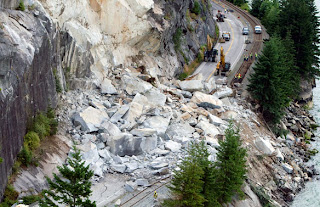A tornado hit Joplin, Mo. around 6 p.m. on May 22, 2011. The tornado left the town with any electricity and all of the phone lines cut. Newton County coroner says that 30 people had been killed and even 11 bodies were found around he same spot. The patients in St. John’s Regional Medical Center had to leave the medical center get away from the fire. Mike Bettes, a meteorologist for the Weather Channel who arrived in Joplin 10 minutes after the tornado touched down, as part of the show "The Great Tornado Hunt" said that the only lights seen were the firetrucks and the ambulances. President Obama said the Federal Emergency Management Agency were being sent.
I think that the tornado was horrible. So many people lost their homes, jobs, friends, families, and their own usual life style.
Liyyee Science
Tuesday, May 31, 2011
Wednesday, May 25, 2011
OMG acid rain... =.=
1.) List a few of the gases which lead to acid rain.
Acid Rain is created by sulfur dioxide and nitrogen oxides when fuels get burned.
2.) What is the source of much of the acid rain producing gases in Pennsylvania?
30 % of the nitrogen oxides causing the acid rain is from power production. Cars create another 30% and agricultural sector makes 25-30%.
3.) Briefly explain how acid rain forms.
Acid Rain forms when the sulfur dioxide and nitrogen oxides in the atmosphere combine with water to forms sulfuric and nitric acid that fall on Earth. Thus creating acid rain.
Acid Rain is created by sulfur dioxide and nitrogen oxides when fuels get burned.
2.) What is the source of much of the acid rain producing gases in Pennsylvania?
30 % of the nitrogen oxides causing the acid rain is from power production. Cars create another 30% and agricultural sector makes 25-30%.
3.) Briefly explain how acid rain forms.
Acid Rain forms when the sulfur dioxide and nitrogen oxides in the atmosphere combine with water to forms sulfuric and nitric acid that fall on Earth. Thus creating acid rain.
Tuesday, February 15, 2011
Reasons for the mudslides
The natural factors: Most of the mudslides occur during the raining season but the earthquakes, hurricanes and the heavy rains help create the earthquakes in Guatemala.
The human factors of the mudslide is the deforestation taking away their protection of the mudslides.
By planting pine trees on top of the mountain can help prevent the mudslides. They also educate the people trying to teach them the way to live with trying to preserve plants and grow more plants as well. Creating a better atmosphere of the people of Guatemala.
The human factors of the mudslide is the deforestation taking away their protection of the mudslides.
By planting pine trees on top of the mountain can help prevent the mudslides. They also educate the people trying to teach them the way to live with trying to preserve plants and grow more plants as well. Creating a better atmosphere of the people of Guatemala.
Monday, January 31, 2011
Gobal Graph...
On the horizontal line represents the years on the graph. The years on the graph marks every 20 years starting at 1860 and ending at 2000.
On the vertical line it shows the temperature. The unit of the temperature is celcius. The range of the graph is -.6 to .6
The place I got my graph says that it got its info in the UK...
On the vertical line it shows the temperature. The unit of the temperature is celcius. The range of the graph is -.6 to .6
The place I got my graph says that it got its info in the UK...
Tuesday, January 18, 2011
Global Stuff
- Paste the following questions onto your blog and answer them there. Use complete sentences please.
- 1 - What do you think the global average temperature is? This means the average for everywhere on Earth, day and night, for an entire year. Explain why you answered what you did.
- I think the average temperature is around 90-80 if its in the summer. For the winter I would think that it is around the 20's or a little lower.
- 2 - People are often talking about "global warming." How much do you think the average global temperature has increased in the past 100 years? Do you think that this is a lot?
- 3 - What do you think is the hottest the Earth has ever been? (since there has been an atmosphere?) How about the coldest the Earth has ever been? Explain why you answered what you did.
Coldest: -20 degrees <---- this is a random guess
- 4 - Are you concerned about "global warming?" Why or why not?
(V)
( - -)
c(")(")
Friday, January 7, 2011
Pg. 266 #4
By having no rain there would be no good soil. With rain there is some good soil, but with even more rain there would be a lot of good soil.
Monday, December 20, 2010
Types of Mass Wasting
"Types of Mass Wasting
Rockfalls and rockslides. Rockfalls occur when pieces of rock break loose from a steep rock face or cliff. These result from the rock face being undercut by rivers or wave action. Frost wedging may also eventually loosen large blocks, causing them to fall. The accumulation of rock debris at the base of a steep slope is called talus."
Read more: http://www.cliffsnotes.com/study_guide/Types-of-Mass-Wasting.topicArticleId-9605,articleId-9506.html#ixzz18fypkHBv
Subscribe to:
Comments (Atom)



